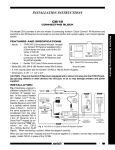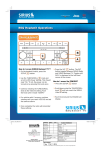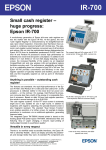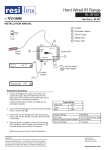Download InRouter 700 Series User`s Manual - Shop Online
Transcript
InRouter 700 Series User’s Manual Second Edition, March, 2013 (For Firmware Version: 1.3.7.r2565) © 2013 InHand Networks, All rights reserved. Republication without permission is prohibited. InRouter 700 Series User’s Manual Copyright Notice Copyright © 2013 InHand Networks All rights reserved. Reproduction without permission is prohibited. Trademarks InHand is a registered trademark of InHand Networks. Other registered marks cited in this manual represented their respective companies. Disclaimer Information in this document is subject to change without notice and does not represent an obligation on the part of InHand Networks. This user manual may include intentional technical or typographical errors. Changes are periodically made to the manual to correct such errors, and these changes are not informed in new editions. Technical Support Contact Information InHand Networks, China Tel: +86-010-64391099 Fax: +86-010-64399872 Email: [email protected] Release Notes 2011. 3. 24th: Add description for functions: 1. WOL (Wakeup Over LAN) at “Networks””LAN”; 2. SMS control (reboot/show status) at “Service””SMS”; 3. “User+X.509” mode for OpenVPN client; Add Notice: 1. WAN/LAN settings: don’t set the WAN/LAN IP as 192.168.3.1 (the default IP of DMZ port); 2011.8.21st: Add description for functions: 1. “Double Dialup”, set backup parameters for PPP dialup at “Networks””Dialup”; 2. “Double IPSec”, set backup IPSec tunnel at “VPN” “IPSec Tunnels”; 3. “DHCP Relay” at “Service” “DHCP Relay”; 4. “DNS Relay” at “Service” “DNS Relay” 5. Enable “SSH configuration”; 6. Disable “Multi Manager” function at “System” “Admin Access”; 7. “Loopback” at “Networks” “Loopback”; 8. “Port Mirror” at “Networks” “Port Mirror”; 2012.1.12th: Add description for functions: 1. Add description for “Multi IP Access”; 2. Add network models for United States market; 3. Add description for “Dynamic GRE”; 4. Add model selection for ICMP; 5. “Status” � “Modem” display changes; 2012.5.8th: Add description for functions: 1. Add short connection for DTU (trigger by serial port); 2. Add the Virtual IP port mapping for “FirewallPort Mapping”; 3. Use two units to display signal strength : asu, dBm content Introduction to InRouter 700 Series ........................................................................................................................................... 3 1.1 Overview ................................................................................................................................................................ 4 1.2 Package Checklist ................................................................................................................................................... 6 1.3 Product Features ..................................................................................................................................................... 7 1.3.1 Interfaces ........................................................................................................................................................... 7 1.3.2 Functions ........................................................................................................................................................... 8 1.3.3 Environmental Limits ........................................................................................................................................ 9 1.3.4 Power Requirements .......................................................................................................................................... 9 1.3.5 Physical Characteristics ..................................................................................................................................... 9 1.3.6 Advanced Industrial Features ............................................................................................................................ 9 1.3.7 Device Management Software ......................................................................................................................... 10 1.3.8 Warranty .......................................................................................................................................................... 10 1.4 Product Models ..................................................................................................................................................... 11 Quick Installation Guide ........................................................................................................................................................... 12 2.1 Typical Application............................................................................................................................................... 13 2.2 Panel Layout ......................................................................................................................................................... 13 2.3 Quick Connection to Internet................................................................................................................................ 15 2.3.1 Insert SIM Card ............................................................................................................................................... 15 2.3.2 Antenna Installation ......................................................................................................................................... 15 2.3.3 Power Supply ................................................................................................................................................... 15 2.3.4 Connect ............................................................................................................................................................ 15 2.3.5 First Connect InRouter with your PC .............................................................................................................. 16 2.3.6 Start to configure your InRouter 700(Optional) .............................................................................................. 18 2.3.7 Connect InRouter with Internet ....................................................................................................................... 19 2.4 Quick IPSec VPN Configuration .......................................................................................................................... 20 2.5 Reset to Factory Defaults ..................................................................................................................................... 22 2.5.1 Hardware Method ..................................................................................................................................... 22 2.5.2 Web Method..................................................................................................................................................... 23 Advanced Configuration .......................................................................................................................................................... 24 3.1 Configuration on Web ........................................................................................................................................... 25 3.1.1 Preparation ....................................................................................................................................................... 25 3.1.2 System ............................................................................................................................................................. 26 3.1.3 Network ........................................................................................................................................................... 30 3.1.4 Service ............................................................................................................................................................. 40 3.1.5 Firewall ............................................................................................................................................................ 44 3.1.6 QoS .................................................................................................................................................................. 46 3.1.7 VPN(For IR79x only) ...................................................................................................................................... 46 3.1.8 Tools ................................................................................................................................................................ 54 3.1.9 Status ............................................................................................................................................................... 55 CLI Configuration .................................................................................................................................................................... 58 4.1 CLI Operation............................................................................................................................................................. 59 4.2 CLI command ............................................................................................................................................................. 61 FQA .......................................................................................................................................................................................... 63 Support ..................................................................................................................................................................................... 65 I Introduction to InRouter 700 Series ◆ Overview ◆ Product Models ◆ Product Features & Specifications ◆ Package Checklist 1.1 Overview InRouter 700 series industrial grade routers provide users with stable and high speed connection between remote devices and customer’s center via 2.5G/3G networks. They allow wide voltage power supply (9-48V DC), large range operating temperature from -25°C to 70°C (-10 ~ 158F)/ humidity: 95% RH, and fully satisfy various EMC verifications, which ensure stability and reliability under harsh industrial conditions. The InRouter 700 can be placed on a desktop or DIN-mounted. InRouter 700 series products support VPN (IPSec/PPTP/ L2TP/GRE/SSL VPN), which create high-security links between remote equipment and customer’s center. In Addition, InRouter 700 series products support the Device Manager remote device manage platform, which realizes remote operation including remote control, remote monitor, parameters configure, firmware upgrade, log/alarm management, information statistics/display, batch configuration/update and etc. Important Safety Information This product is not intended for use in the following circumstances Area(s) where radio transmission equipment (such as cell phone) are not permitted. Hospitals, health care facilities and area(s) where cell phones are restricted by law. Gas stations, fuel storage and places where chemical are stored. Chemical plants or places with potential explosion hazard. Any metal surface that may weaken the radio signal level. RF safety distance For GPRS router, the compliance boundary distance is r=0.26m for GSM 900MHz and r=0.13m for DCS 1800 MHz. For HSUPA router, the compliance boundary distance is r=0.26m for GSM 900MHz and r=0.13m for DCS 1800 MHz, r=.0.094 for WCDMA 900MHz, r=0.063 for WCDMA 2100MHz. Warning This is a class A product. In a domestic environment this product may cause radio interference in which case the user may be required to take adequate measures. WEEE Notice The Directive on Waste Electrical and Electronic Equipment (WEEE), which entered into force as European law on 13th February 2003, resulted in a major change in the treatment of electrical equipment at end-of-life. The purpose of this Directive is, as a first priority, the prevention of WEEE, and in addition, to promote the reuse, recycling and other forms of recovery of such wastes so as to reduce disposal. The WEEE logo (shown at the left) on the product or on its box indicates that this product must not be disposed of or dumped with your other household waste. You are liable to dispose of all your electronic or electrical waste equipment by relocating over to the specified collection point for recycling of such hazardous waste. Isolated collection and proper recovery of your electronic and electrical waste equipment at the time of disposal will allow us to help conserving natural resources. Moreover, proper recycling of the electronic and electrical waste equipment will ensure safety of human health and environment. For more information about electronic and electrical waste equipment disposal, recovery, and collection points, please contact your local city centre, household waste disposal service, shop from where you purchased the equipment, or manufacturer of the equipment. 1.2 Package Checklist We put each InRouter 700 cellular router in a box with standard accessories. Additionally, there’re optional accessories can be ordered. When you receive our package, please check carefully, and if there’re items missing or appearing to be damaged, please contact with your InHand Networks sales representative. Items in package include: Standard Accessories: Accessories Description InRouter 700 Serials Wireless Router Cable 1 1 Cross line,CAT-5,1.5M Document and Software CD Antenna 1 5m Cellular Antenna Power Supply Power Adapter, 100-265V AC in, 12V DC out (included in IR7xx) Power plug, American Standard (included in IR7xx) Optional Antennas: Picture Type Description GSM/GPRS Cellular Antennas GPRS Quad-band (included in IR7xxGS55) UMTS/HSDPA/WCDMA Antennas UMTS Quad-band (included in IR7xxWH01) Cellular Anti-thief antenna UMTS Quad-band (Optional for IR7xxWH01) Stick antenna UMTS Quad-band (Optional for IR7xxWH01) Anti-thief antenna UMTS Quad-band (Optional for IR7xxWH01) 1.3 Product Features 1.3.1 Interfaces WAN Cellular WAN: Band Options: HSUPA /HSDPA/WCDMA 850/900/1900/2100MHz GSM/GPRS/EDGE 850/900/1800/1900MHz Ethernet WAN: Ethernet: 10/100 Mbps, RJ45 connector, Auto MDI/MDIX Magnetic Isolation Protection: 1.5 KV built-in LAN IR701/791: Number of Ports: 1 Ethernet: 10/100 Mbps, RJ45 connector, Auto MDI/MDIX Magnetic Isolation Protection: 1.5 KV built-in IR704/794: Number of Ports: 4 Ethernet: 10/100 Mbps, RJ45 connector, auto MDI/MDIX Magnetic Isolation Protection: 1.5 KV built-in Serial A. Serial Type: RS232/485 B. Data bit: 5/6/7/8 C. Stop bit: 1/2 D. Check bit: N/O/D E. Baud rate: 1,200bit/s~ 115,200bit/s SIM Interface SIM Control: 3 V 1.3.2 Functions PPP Support VPDN/APN, fast access to virtual private dial-up network (VPDN) provided by mobile operator, ensure high-security data transmission. Support PPPoE (Point to Point Protocol over Ethernet) Protocol. Support CHAP/PAP/MS-CHAP/MS-CHAP V2 authorization Support Connection Detection, auto-recovery, auto-link, ensure reliable communication. Support On-demand connection, SMS Activity Dynamic IP Support DHCP, applied as Server/Client Dynamic DNS Support Dynamic DNS-IP Binding Flux Management Support rate limiting, Firewall Function Package filtering Port Mapping Virtual Address Mapping DMZ zone MAC addresses binding. Route function Support Static Routing Table VPN (for IR79x only) IPSec VPN L2TP VPN PPTP VPN GRE SSL VPN Link Backup VRRP Support VRRP protocols, realizing immediate link backup Hot Link Backup (for IR7x4 only) Support Wireless Hot Link Backup for cable link via only one device DNS Forwarding Support DNS Forwarding, support DNS record Network tools Support Ping, Trace Route and Telnet Wakeup Over LAN (WOL) Support Wakeup over LAN, to wakeup industrial PC over Eth. after receives SMS. RSSI + Cell ID Display 1.3.3 Environmental Limits Operating Temperature: -25 to 70°C (-10 to 158°F) Operating Humidity: 5 to 95% RH Storage Temperature: -40 to 85°C (-40 to 167°F) 1.3.4 Power Requirements Power Inputs: 1 terminal block, including power jack and serial. Input Voltage: 9 -48 VDC 1.3.5 Physical Characteristics Housing: Steel, providing IP30 protection Weight: 490g Dimensions (mm) IR701/791: Side View IR704/794: DIN Rail Kit Side View Front View Front View 1.3.6 Advanced Industrial Features Physical Characteristics Housing: Metal, IP30 EMC Features ESD: EN61000-4-2, level 4 Surge: EN61000-4-5, Level 3 Electric Fast Transient/burst: EN61000-4-4, Level 4 RF Electromagnetic Field Immunity: EN61000-4-3, Level 3 Rear View Back View DIN Rail Kit RF conducted interference: EN61000-4-6, Level 3 Damped oscillation Immunity: EN61000-4-12, Level 3 Power-frequency electromagnetic fields Immunity: EN61000-4-8, Level 5 Anti-shock: IEC60068-2-27 Drop: IEC60068-2-32 Vibration: IEC60068-2-6 1.3.7 Device Management Software Device Manager: Centralized management solution for InHand Networks Devices 1.3.8 Warranty Warranty Period: 1 year (Optional service for 3 years) 1.4 Product Models The current models of InRouter700 Series include: InRouter701/791GS55,InRouter701/791WH01,InRouter 704/794WH01. The models are classified according to main difference including cellular network, VPN support and interface for device. Model Serial LAN RS232/485 1 RJ45 Cellular WAN Ethernet WAN VPN CA X.509 base64 GPRS GSM/GPRS IR701GS55 N/A N/A N/A N/A IPSec/PPTP/L2TP/GRE/SSL Support N/A N/A N/A N/A IPSec/PPTP/L2TP/GRE/SSL Support N/A N/A IPSec/PPTP/L2TP/GRE/SSL Support 850/ 900/1800/1900 MHz GSM/GPRS IR791GS55 RS232/485 1 RJ45 850/ 900/1800/1900 MHz UTMS HSUPA /HSDPA/WCDMA: 850/900/1900/2100MHz IR701WH01 RS232/485 1 RJ45 GSM/GPRS/EDGE: , 850/900/1800/1900MHz HSUPA /HSDPA/WCDMA: 850/900/1900/2100MHz IR791WH01 RS232/485 1 RJ45 GSM/GPRS/EDGE: , 850/900/1800/1900MHz IR704WH01 IR794WH01 RS232/485 RS232/485 WCDMA/HSUPA ADSL/DHCP/ 850/900/1900/2100MHz PPPoE/Static IP 4 RJ45 WCDMA/HSUPA ADSL/DHCP/ 850/900/1900/2100MHz PPPoE/Static IP 4 RJ45 USB Modem IR701UE RS232/485 1 RJ45 USB Modem N/A N/A N/A IR791UE RS232/485 1 RJ45 USB Modem N/A IPSec/PPTP/L2TP/GRE/SSL Support IR704UE RS232/485 4 RJ45 USB Modem N/A N/A IPSec/PPTP/L2TP/GRE/SSL Support ADSL/DHCP/ PPPoE/Static IP ADSL/DHCP/ IR794UE RS232/485 4 RJ45 USB Modem PPPoE/Static IP II Quick Installation Guide ◆ Typical Application ◆ Panel Layout ◆ Quick Connect to Internet ◆ Quick IPSec VPN Configuration ◆ Reset to Factory Defaults 2.1 Typical Application InRouter 700 series can be used to connect your device (with RS232/485/Ethernet Interface) to internet via GPRS/HSUPA cellular network. Meanwhile, to ensure the security and access, InRouter 700 series support VPN, enabling remote access and secure data transmission through Internet. 2.2 Panel Layout IR701/791: IR704/794: Interface Description Power Interface Access 9-48 V DC Power Supply Serial Access to the serial line, realizing One 10/100Base-TX RJ45 Port (IR701/791GS55, IR701/791WH01, IR701/791UE) Ethernet Ports Four 10/100Base-TX RJ45 Ports, (IR704/794UE, IR704/794WH01) ANTENNA SIM Card Connector 2.5G/3G antenna Hold SIM card Description of LED Legend: On-- Off-- Blink-- Power on Connect to internet Start to run firmware Begin dial to Internet Upgrading firmware Restore factory default Signal Status LED Description ----- Signal: 1-9 (poor signal level, router cannot work, please check the antenna and local signal level) ------ Signal: 10-19 (Router can work under this signal level) ------ Signal: 20-31 (Perfect signal level) 2.3 Quick Connection to Internet 2.3.1 Insert SIM Card Open InRouter SIM/UIM card case at the bottom, insert the SIM card and close the case. USB Modem For the external USB modem type, insert the USB card into the USB port. 2.3.2 Antenna Installation After install the IR700, connect the interface of enhanced antenna to the interface of skin antenna and screw closely. Put the amplifier of enhanced antenna to where it can receive the good signal. Attention: Position and angle of the antenna may influence the quality of signal. 2.3.3 Power Supply Link the power supply in the product package with InRouter, watch where the InRouter Power LED on the panel is light up. If not, please connect with InHand for technical supports. You can configure IR700 after the Power LED lights up. 2.3.4 Connect Link IR700 with PC: (1) Using the cable to link IR700 with PC; (2) After connected, you can see one LED of RJ45 Interface turns green and the other flashes. 2.3.5 Build Connection between InRouter and your PC IR700 Router can auto-distribute IP address for PC. Please set the PC to automatically obtain IP address via DHCP. (Based on the Windows Operation System): 1) Open “Control Panel”, double click “Network Connections” icon, and enter “Network Connections” Screen. 2) Double click “Local Area Connection”, enter “Local Area Connection Status” screen: 3) Click “Properties”, enter “Local Area Connection Properties” screen Choose “Internet Protocol (TCP/IP)”, click “properties” button, ensure your PC can obtain IP and DNS address automatically. (Or you can set your PC in the subnet: 192.168.2.0/24, for example, set IP: 192.168.2.10, Net Mask: 255.255.255.0, Default Gateway: 192.168.2.1) Click “OK”, InRouter will allocate an IP address: 192.168.2.X, and a gateway: 192.168.2.1(the default address of IR700). After configure TCP/IP protocols, you can use ping command to check whether the link between PC and Router is built correctly. Below is an example to execute Ping command under Windows XP: Ping 192.168.2.1 If the screen shows: Then the PC and InRouter are correctly connected. Else if it shows: The connection is not built, you need to check step by step starting from Section 2.3.4. 2.3.6 Start to configure your InRouter 700(Optional) After you have finished the former steps, you can configure the Router: 1) Open IE browser, input the default IP address of the Router: http://192.168.2.1, you can see the login page as below: Input “username” (default: adm) and the “password” (default: 123456), then click “login” to enter the operation screen. 2) Change the IP configuration: Attention: After updating the configuration, please click “apply” to activate your configuration. If you want to set your own IP of InRouter 700, please follow the instructions below: Click “Network”=>“LAN”, change the IP address to 192.168.1.254: 3) Click “Apply”, then you will see: Now the IP address of IR700 has been reset, and in order to enter the configuration page, you need to set your PC in the same subnet as InRouter, for example: 192.168.1.10/24 then input the updated IP address (192.168.1.254) in your IE Browser. 2.3.7 Connect InRouter with Internet Follow the configuration steps below to enable IR700 to connect to Internet. Click “Network”=>“Dialup”, enter dialup configuration interface: Please check the APN, Dialup Number, Username and Password: Dialup Number, Username and Password are provided by local mobile operator. The following examples show parameters provided by China Mobile, Vodafone. Please contact with local operator for details. 1: China Mobile APN: CMNET Phone Number: *99# User Name: web Password: web 2: Vodafone APN: internet Phone Number: *99# User Name: web Password: web After correctly configurting, InRouter 700 can now access Internet. Open IE Browser, input www.google.com, you should see the Google home pages: 2.4 Quick IPSec VPN Configuration If you need to build a VPN tunnel to access to your remote PLC through Internet or you need to ensure security of the data transmission, here’s a quick configuration guide of IPSec for InRouter700 Series Connect PC with Router to enter router configuration interface, select “VPN” => “IPSec setting”: Enable NAT-Traversal (NATT): select enable. Keep alive time interval of NATT: set the “Keep alive time interval of NATT”, default is 60 seconds. Enable Compression: select enable. Please change the parameters according to actual situation. Click “Apply” to complete the configuration. 1) Select “VPN”=> “IPSec Tunnels” to check or modify parameters of IPSec Tunnels. Click “Add” to add a new IPSec Tunnel: Basic Parameters: basic parameters of IPSec tunnel. Tunnel Name: name IPSec tunnel, the default is IPSec_tunnel_1. Destination Address: set to VPN server IP/domain, e.g.: the domain provided by GJJ is gjj-ovdp.3322.org. Startup Modes: select Auto Activated. Negotiation Mode: optional between Main Mode and Aggressive Mode. Generally, select Main Mode. IPSec Protocols: optional among ESP, AH. Generally, select ESP. IPSec Mode: optional between Tunnel Mode and Transport Mode. Generally, select Tunnel Mode. Tunnel Type: optional among Host-Host, Host-Subnet, Subnet-Host and Subnet-Subnet. Local Subnet: IPSec local subnet protected. E.g.: 172.16.16.0. Local Net Mask: IPSec local Net Mask protected. E.g.: 255.255.255.252. Remote Subnet: IPSec remote subnet protected. E.g.: 172.16.0.0. Remote Net Mask: IPSec remote Net Mask protected. E.g.: 255.240.0.0. Phase 1 Parameters: configuration parameters during Phase 1 of IPSec negotiation. IKE Policy: optional between 3DES-MD5-96 and AES-MD5-96, suggest selecting 3DES-MD5-96. IKE Lifetime: the default is 86400 seconds. Local ID Type: optional among FQDN, USERFQDN, IP address, suggest selecting IP address. Remote ID Type: optional among FQDN, USERFQDN, IP address, suggest selecting IP address. Authentication Type: optional between Shared Key and Certificate, generally choose Shared Key. Key: set IPSec VPN negotiating key. Phase 2 Parameters: configuration parameters during Phase 2 of IPSec negotiation. IPSec Policy: optional between 3DES-MD5-96 and AES-MD5-96, suggest selecting 3DES-MD5-96. IPSec Lifetime: the default is 3600 seconds. Perfect Forward Encryption: Optional among None, GROUP1, GROUP2 and GROUP5. This parameter should match with the server, generally, select “None”. Click “Save” to finish adding IPSec Tunnel: You can click “Show Detail Status” to observe the specific connection details, or click “Add” to add a new tunnel.: Now you have successfully built a high-security IPSec tunnel. Here’s an example. We set an IPSec Tunnel from subnet: 192.168.220.0/24 to subnet: 192.168.123.0/24, when it succeeds, the screen will show: And the PC in IPSec client subnet can get access to the server’s subnet. Open command in your PC, then ping a PC in the server’s subnet: 2.5 Reset to Factory Defaults 2.5.1 Hardware Approach Legend: On-- Off-- Blink-- 1) Press and hold RESET button while turning on IR700: 2) When you see ERROR LED turns on (about 10 seconds after power on), release the RESET button: 3) After a few seconds, the ERROR LED then turns off, now press RESET button again: 4) Then you will see ERROR and STATUS LED blink, which means reset to factory defaults succeed! Factory default settings: IP: 192.168.2.1 Net Mask: 255.255.255.0 Serial parameter: 19200-8-N-1 2.5.2 Web Approach 1) Login the web interface of IR700, select “System””Config Management”: 2) Click “Restore default configuration” to Reset IR700. III Advanced Configuration ◆ Configuration on Web 3.1 Configuration on Web InRouter must be correctly configured before use. This Chapter will show you how to configure InRouter via Web interfaece. 3.1.1 Preparation Firstly, connect your devices to IR700 with a cable or a HUB (switch), then set the IP of PC and IR700 in the same subnet, for example: Set PC IP to 192.168.2.50, net mask: 255.255.255.0, gateway (default IP of IR700: 192.168.2.1 ): Open IE browser, input the IP address of IR700: http://192.168.2.1 (default IP of IR700). Then you’ll see the Login Window pop up, you need to login as Administrator. Input the username and password (default: adm/123456). Click “Login” to enter configure interface: 3.1.2 System System settings include the 9 parts: Basic Setup, Time, Serial Port, Admin Access, System Log, Config Management, Update, Reboot and Logout. (1) Basic Setup Parameters Name Description Default Example Language Choose language of configuration web Chinese English Router Name Set Router My InRouter Host Name Name the device/PC linked with IR700 Router My InRouter name of InRouter (2) Time Name Description Router Time Display router time PC Time Display PC time Default 1970-1-1 8:00:00 (or the time of device linked with router) Time Zone Set time zone Custom Custom TZ string Set the string of time zone of Router CST-8 Auto Update Time Time Update Interval Disabled NTP Time Servers (after enable the Setting for NTP Time server. (Three at the most) pool.ntp.org Auto Update Time) (3) Serial Port Name Description Default Baud Rate Serial baud rate 19200 Data Bit Serial data bits 8 Parity Set parity bit of serial data. None Stop Bit Set stop bit of serial data. 1 Hardware Flow Control Enable Hardware Flow Control Disable Software Flow Control Enable Software Flow Control Disable (4) Admin Access Name Description Default Username/Password Username Username for configuration web login adm Old Password To change the password, you need to input the old one 123456 New Password Input new password Confirm New Password Input the new password again Management HTTP/HTTPS/TELNET/SSHD/Console Enable Select to enable Enable Service Type HTTP/HTTPS/TELNET/SSHD/Console 80/443/23/22/Blank Local Access Enable—allow manage Router by LAN(e.g.: HTTP) Enable Disable—forbid manage Router by LAN. Remote Access Enable—allow to manage IR700 by WAN. (e.g.: HTTP) Enable Disable—forbid to manage IR700 by WAN. (e.g.: HTTP) Allowed Access from WAN Set the range of allowed IP address for WAN Control services server can be set at (Optional) (HTTP/HTTPS/TELNET/SSHD) this time, for example 192.168.2.1/30 or 192.168.2.1-192.168.2.10 Description Describe the parameters of management (non-influence to IR700) Other Parameters Log Timeout Set the Log Timeout, configuration web will be disconnected after timeout 500 seconds (5) System Log Name Description Default Log to Remote System Enable remote log server Disable IP address/Port (UDP) Set the IP and Port of remote log server Port: 514 (6) Config Management Name Description Router Configuration Import/Backup configuration file Restore default configuration Click to reset IR700 (to enable RESET, you need to reboot IR700) Network Provider (ISP) Used to configure the APN, username, password and other parameters of major operators (7) System Upgrade To upgrade the system, click “System”=>”System upgrade” to enter upgrade page, then follow the steps below: Click “Browse”, choose the upgrade file; Click “update”, and then click “sure” to begin update, the window will show as below. Upgrade firmware succeed, and click “reboot” to restart IR700. (8) Reboot If you need to reboot system, please click ”System”=>”Reboot”, Then click ”OK” to restart system. (9) Logout If you need to logout system, click “System”=>”Logout”, and then click “OK”. 3.1.3 Network Network settings include Dialup, LAN, DNS, DDNS, Static Route, and etc. (1) Dialup Name Description Default Enable Enable PPP dialup Enable Time Schedule Set time for online and offline ALL SHARED Enabled—device linked with Router Can access to internet. Enable Disable—device Can NOT access to internet via Router. ISP Select local ISP, if not listed here, please select ”Customer” Customer Network Select Type Choose mobile network type HSDPA (or GPRS) APN APN parameters provided by Local ISP, you can set TWO different group of cmnet/uninet dialup parameters (APN/Username/Password) and set one as backup Access Number Dialup parameters provided by Local ISP “*99#”“*99***1#” or #777 Username Dialup parameters provided by Local ISP “gprs” or ”CDMA” Password Dialup parameters provided by Local ISP “gprs” or ”CDMA” Primary Profile Retries After retries and dialup still failed, router will try backup dialup parameters (if you 0 have set two IPSec tunnels and one as backup, router will also stop the main one and parameters and never use try another, more details please see at “VPN” “IPSec” ) backup) Static IP Enable Static IP if your SIM card can get static IP address Disable Connection Mode Optional Always Online, Always Online Redial Interval When Dial fails, InRouter will redial after the interval 30 seconds Show Advanced Options Enable configure advanced options Disabled Initial Commands Used for advanced parameters Blank Dial Timeout Set dial timeout (IR700 will reboot after timeout) 120 seconds MTU Set max transmit unit 1500 MRU Set max receive unit 1500 TX Queue Length Set length of transmit queue 3 Enable IP header compression Enable IP header compression Disabled Use default asyncmap Enable default asyncmap, PPP advanced option Disabled Using Peer DNS Click Enable to accept the peer DNS Enabled Link Detection Interval Set Link Detection Interval 30 seconds Link Detection Max Retries Set the max retries if link detection failed 3 Debug Enable debug mode Enable Expert Option Provide extra PPP parameters, normally user needn’t set this. Blank MONITOR TRAFFIC Ignore Traffic (always When InRouter detected there are “business” data (DTU,IPSec) receive or transmit, InRouter will not send ICMP probe packet. When detected without business data, InRouter will send ICPM probe packet IGNORE TRAFFIC ICMP Detection Mode No matter whether InRouter have some data receive or transmit(DUT,IPSec data), InRouter always send the ICMP probe packet. HANDOVER ONLY InRouter send the ICMP probe Packet when the field change from a base station to other station. ICMP Detection Server Set ICMP Detection Server, blank represents none Blank ICMP Detection Interval Set ICMP Detection Interval 30 seconds ICMP Detection Timeout Set ICMP Detection Timeout (IR700 will reboot if ICMP time out) 5 seconds ICMP Detection Max Retries Set the max number of retries if ICMP failed 5 Dialup----Time Schedule Management: Name Name Description Name the schedule Default schedule 1 Sunday Blank Monday Enable Tuesday Enable Wednesday Enable use main Thursday Enable Friday Enable Saturday Blank Time Range 1 Set Time Range 1 9:00-12:00 Time Range 2 Set Time Range 2 14:00-18:00 Time Range 3 Set Time Range 3 0:00-0:00 Description Describe configuration Blank (2) WAN (for IR7x4 only) This page is to set the type of WAN port: Name Description Type Static IP; Default Disabled Dynamic Address(DHCP); ADSL Dialup(PPPoE); Disabled Attention: There can only be one WAN type at one time, enabling one type WAN will disabled another. WAN—Static IP Notice: please DO NOT set WAN address as: 192.168.3.x (an IP for DMZ port). Name Description Type Static IP SHARED Enabled—the local device linked with Router can get access to Default Enable internet. Disable—the local device can’t get access to internet via Router. MAC Address Set MAC Address IP Address Set WAN port IP 192.168.1.29 Net Mask Set WAN port Net Mask 255.255.255.0 Gateway Set WAN Gateway 192.168.1.1 MTU Set Max Transmission Unit, optional between default and manual 1500 Multi-IP Settings(can set 8 additional IP address at the most) IP address Set the additional IP address of LAN Blank Net Mask Set Net Mask Blank Description Describe the settings Blank WAN—Dynamic Address (DHCP) Name Description Type Dynamic Address (DHCP) SHARED Enabled—the local device linked with Router can get access to Default Enable internet. Disable—the local device can’t get access to internet via Router. MAC Address Set MAC Address MTU Set Max transmission unit, optional between default and manual 1500 WAN --ADSL Name Description Type ADSL Dialup (PPPoE) Default SHARED Enabled—the local device linked with Router can get access to internet. Enable Disable—the local device can’t get access to internet via Router. MAC Address Set MAC Address MTU Set Max Transmission Unit, optional between default and manual 1500 ADSL Dialup (PPPoE) Settings Username Set username for dialing up Blank Password Set password for dialing up Blank Static IP Enable Static IP Disabled IP address Static IP Address Blank Peer IP Set Peer IP Blank Connection Mode Set connection mode (Connect on Demand/Always Online/ Manual) Always Online Advanced Options Show advanced options Enable advanced configuration Disabled Service Name Name the service Blank TX Queue Length Set TX Queue Length 3 Enable IP head compression Click to enable IP head compression Disabled User Peer DNS Enable User Peer DNS Disabled Link Detection Interval Set link detection interval 55 seconds Link Detection Max Retries Set link detection max retries 10 (times) Debug Select to enable debug-mode Disabled Expert Options Set expert parameters Blank ICMP Detection Server Set ICMP Detection Server Blank ICMP Detection Time Set ICMP Detection Time 30 ICMP Detection Timeout Set ICMP Detection Timeout 3 ICMP Detection Max Reties Set ICMP Detection Max Reties 3 (3) Link Backup (for IR7x4 only) Link Backup, to realize link backup between Cellular WAN and Ethernet WAN, when one fails, IR700 will try the other Name Description Default Enable Enable Link Backup service Disabled Main Link InRouter will choose this for normal WAN connection WAN (Ethernet WAN) ICMP Detection Server ICMP can ensure a link to certain destination ICMP Detection Interval Time interval between ICMP packages 10 ICMP Detection Timeout Timeout for each ICMP package 3 (seconds) ICMP Detection Max Retries After the retries if no ICMP succeed, dialup will try the backup link 3 Backup Link Select the backup link WAN (4) LAN Notice: please DO NOT set LAN address as: 192.168.3.x (an IP for DMZ port). Name Description Default MAC Address The MAC address in LAN 00:10:A1:86:95:02 (Provided by InHand) , for manufactures IP Address Set IP Address in LAN 192.168.2.1 (If Changed, you need to input the new address for entering the configuration web) Net Mask Set Net Mask of LAN 255.255.255.0 MTU Set MTU length, optional between Default and Manual 1500 Detection Host Set Detection Host Address 0.0.0.0 WOL MAC Address Set the MAC of PC in the LAN of router, for Wakeup Blank Over LAN (WOL) function, you should also set “Networks” “Dialup” and change dialup mode into “Trigger by SMS”. Multi-IP Settings (Support additional 8 IP addresses at the most) IP Address Set additional IP Address of LAN Blank Description Description about this IP address Blank (5) Loopback Name Description Default IP Address The IP Address for loopback 127.0.0.1 Net Mask Set Net Mask of loopback host 255.0.0.0 Multi-IP Settings (Support additional 8 IP addresses at the most) IP Address/Net mask Set additional IP/Net mask of loopback host Blank Description Description about this IP address Blank (6) DMZ Port (for IR7x4 only) Configure this page after select WAN-DMZ-LAN mode in Port Mode page. Name MAC Address Description Set MAC address of DMZ port Default (Provided by Manufacture: InHand) IP Address Set IP Address of DMZ port 192.168.3.1 Net Mask Set Net Mask of DMZ port 255.255.255.0 MTU Optional between Default & Manual Default (1500) Multi-IP Settings (8 additional IP address at the most) IP Address Set additional IP address for DMZ port Blank Net Mask Set Net Mask Blank Description Description of additional IP address Blank (7) Port Mode (for IR7x4 only) Notice: please DO NOT set WAN IP/LAN IP/DMZ IP the same; it will disable your link to internet! Name Port Mode Descriptions LAN (four LAN ports) WAN-LAN (3 LAN ports and 1 WAN port) WAN-DMZ-LAN (1 WAN port, 1 DMZ port and 2 LAN ports) Default WAN-DMZ-LAN (8) Port Mirror (for IR7x4 only) This function is used for Engineer capture packages of different ports of IR700. Destination Port: the port to which you wand to send the copied packages. Here we set Port 3 as example, after you set Port 1 as destination port, and Port 3“Both”, you can link your PC to Port 1 and get the packages sent and received by Port 3. (9) DNS Name Description Default Primary DNS Set Primary DNS Blank Secondary DNS Set Secondary DNS Blank (10) DDNS (Dynamic DNS) Name Description Default Current Address Show the current IP address Blank Service Type Select DDNS Provider Disabled Name Description Service Type DynDNS - Dynamic URL http://www.dyndns.com/ Username Registered username for DDNS Password Registered password for DDNS Hostname Registered hostname for DDNS Default (11) Static Route Name Description Default Destination Set IP address of destination Blank Net Mask Set subnet Mask of destination 255.255.255.0 Gateway Set the gateway of destination Blank Interface Optional LAN/WAN port access to destination Blank Description Describe static route Blank 3.1.4 Service Service settings include DHCP Service, DNS Forwarding, VRRP and other related parameters. (1) DHCP Service Name Description Default Enable DHCP Click to enable DHCP Enable IP Pool Starting Address Set the starting IP address of DHCP pool 192.168.2.2 IP Pool Ending Address Set the ending IP address of DHCP pool 192.168.2.100 Lease Set the valid time lease of IP address 60 minutes obtained by DHCP DNS Set DNS Server 192.168.2.1 Windows Name Server Set WINS Blank (WINS) Static DHCP (can set 20 designated IP address at the most) MAC Address Set the MAC address of a designated IP Blank address IP address Set the static IP address 192.168.2.2 Host Set the hostname Blank (2) DNS Relay Name Enable DNS Relay Description Click to enable DNS Relay Default Disabled Designate IP address<=>DNS couples (20 at the most) IP Address Set IP address <=> DNS couples Blank Host Set the name of IP address <=> DNS couples Blank Description Describe IP address <=> DNS couples Blank (3) DHCP Relay This function can realize DHCP relay and send relay packages to LAN interface of router. Name Description Default Enable DHCP Relay Click to enable DHCP Relay Enable (after enable DHCP) DHCP Server Set the DHCP Server’s address, always you need Blank ensure DHCP server is in the same LAN or VPN subnet as IR700’s LAN Source IP The interface IR700 will forward the DHCP Blank acknowledge packages (always set the LAN IP of IR700) (4) VRRP Name Description Default Enable Select to enable VRRP Disable Group ID Select group id of routers (range 1-255) 1 Priority Select priority for router (range 1—254) 10 (bigger number stands for higher priority) Advertisement Interval Set ad interval 60 sec Virtual IP Set Virtual IP Blank Authentication Type Optional: None/Password type None (5) Device Manager Name Mode Description Disabled/Only SMS/SMS+IP Name Default Disable Description Mode Only SMS Query SMS Interval Set how long to check SMS Trust Phone List Add trust Cell Phone List Name Default 24 hours Description Default Mode SMS+IP Mode Vendor Set Vendor Name Device ID Set Device ID Server Set Device Manager Server IP Port Set Port For DM 9000 Login Retries Set login retries 3 Heartbeat Interval Set interval of heartbeat 120 Packet Receiving Timeout Set packet receiving timeout 30 Packet Transmit Retries Set packet transmit reties 3 Default Query SMS Interval Set how long to check SMS Trust phone list Set trust cell phone list 24 (6) DTU Name Description Default Enable Click to enable DTU Disable DTU Protocol Set DTU protocol, Please see more in related Quick Guide Transparent Protocol Optional between TCP/UDP UDP Mode Set DTU as client or server Client Frame Interval Set Frame Interval 100 Serial Buffer Frames Set Serial Buffer Frames 4 Multi-Server Policy Set Multi-Server Policy: Parallel/ Poll Parallel DTU ID Set ID of DTU Blank Multi Server Set the IP address and Port of server to receive data. Blank (7) SMS Name Enable Description Click to enable SMS control Default Disable Status Query Set Status Query SMS, and you can see status of router by send SMS (e.g.: show status). Reboot Let the router reboot SMS Access Control Default Policy Block or Accept control SMS from certain Phone Phone List Include phone numbers accepted or blocked to send Block SMS to router Notice: Before using this function, please make sure you have a SIM card in the router that has SMS function. Otherwise, please contact local mobile operator to get one. SMS you will get in your mobile phone: Host: (SN); Uptime: (the uptime of router for this time of reboot); State: (Online/Offline) (Cellular WAN IP) LAN: (Up) (LAN IP) 3.1.5 Firewall This page is to configure the firewall parameters (1) Basic Configuration Name Description Default Default Filter Policy Optional between Accept /Refused Accept Block Anonymous WAN Request (ping) Click to enable filer ping request Disable Filter Multicast Click to enable filter multicast Enable Defend DoS Attack Click to enable Defend DoS Attack Enable (2) Filtering Name Description Default Enable Click to enable filtering Blank Protocol Optional among TCP/UDP/ICMP All Source IP address Set Source IP address Blank Source Port Set Source Port Blank Destination IP Set destination IP Blank Destination Port Set destination port Blank Action Accept/Deny Accept Log Click to enable login Disable (3) Port Mapping Name Description Default Enable Click Enable Port Mapping Disable Source To fill with source IP 0.0.0.0/0 Service Port Fill the port of service 8080 Internal Address Set the internal IP for mapping Blank Internal Port Set the Port mapping to internal 8080 Log Click to enable log about port mapping. Disable External Address(Optional) Set the virtual IP or tunnel name which get Blank /Tunnel Name(OpenVPN) Description in VPN Describe meanings of each mapping Blank (4) Virtual IP Mapping An internal PC’s IP can match to a virtual IP, and external network can access to internal PC via this virtual IP address. Name Description Default Virtual IP for Router Set Virtual IP for Router Blank Source IP Range Set range of source IP address Blank Virtual IP Set virtual IP Blank Real IP Set real IP Blank Log Enable logging concerned with virtual IP Disable Description Describe this configuration Blank (5) DMZ (All Port Mapping) Mapping all the ports and then external PC can get access to all the ports of internal device behind IR700. Attention: this function cannot map the admin port of IR700 (e.g.: 80 TCP) to the device’s port. Name Description Default Enable DMZ Click to Enable DMZ Disable DMZ Host Set host IP of DMZ Blank Source Address Range Set IP address with restrict IP access Blank (6) MAC-IP Bundling When firewall denies all access to the external network, only PC with MAC-IP Bundling can access external network Name Description Default MAC Address Set Bundling Mac address Blank IP Address Set Bundling IP address 192.168.2.2 Description Describe this configuration Blank 3.1.6 QoS Name Description Enable Click to enable Outbound Limit Max Set Bandwidth bandwidth Inbound Limit Max Set the limit speed of inbound bandwidth the limit Default Disable speed of out- bound 100000kbit/s 100000kbit/s Bandwidth 3.1.7 VPN(For IR79x only) This page introduces the parameters in InRouter 700’s Web. (1) IPSec Settings To build an IPSec VPN Tunnel, you need first set IPSec properties in this page, then turn to IPSec Tunnels to add your VPN: IPSec Settings Description: 1. Select to Enable or Disable NATT, normally we need to enable, unless you ensure there is no NAT routers in the network. 2.Select to enable Compression Mode or Debug Name Enable NAT Transversal Description Default Click to enable NATT Enable Keep alive time interval of NATT Set live time for NATT 60 sec Enable Compression Click to enable Enable Enable Debug Click to enable Disable Force NATT Click to enable Disable (NATT) (2) IPSec Tunnels Click “Add” and enter the configuration web: Name Show Advanced Options Description Default Click to enable advanced options Disable Basic Parameters Tunnel Name To name the tunnel IPSec_tunnel_1 Destination Address Set the destination address of IPSec VPN Server Blank Startup Mode Auto Activate/Trigged by Data/Passive/Manually Activated Enable Negotiation Mode Optional: Main Mode or Main Mode Aggressive Mode IPSec Mode Optional: ESP or AH ESP Optional: Tunnel Mode or Transport Mode Tunnel Mode Optional: Subnet——Subnet Mode (Enable Advanced options) IPSec Mode (Enable Advanced options) Tunnel Type Host——Host, Host——Subnet, Subnet——Host, Subnet——Subnet Local Subnet Set IPSec Local Protected Subnet 192.168.2.1 Local Subnet Net Mask Set IPSec Local Protected Subnet Net Mask 255.255.255.0 Remote Subnet Address Set IPSec Remote Protected Subnet Blank Remote Subnet Net Mask Set IPSec Remote Protected Subnet Net Mask 255.255.255.0 Phase 1 Parameters IKE Policy Optional: 3DES-MD5-96 or AES-MD5-96 3DES-MD5-96 IKE Lifetime Set IKE 的 Lifetime 86400 sec Local ID Type Optional: FQDN, USERFQDN, or IP Address IP Address Local ID (Only for FQDN 和 USERFQDN) Set the ID according to ID type Blank Remote ID Type Optional: FQDN, IP Address USERFQDN, or IP Address Remote ID (Only for FQDN and USERFQDN) Set the ID according to ID type Blank Authentication Type Optional: Shared Key or Certificate Shared Key Key (While choosing Shared Key Authentication Set IPSec VPN Negotiation Key Blank Type) Phase 2 Parameters IPSec Policy Optional: 3DES-MD5-96 or AES-MD5-96 3DES-MD5-96 IPSec Lifetime Set IPSec Lifetime 3600sec Perfect Forward Secrecy (PFS) Optional: Disable, GROUP1, GROUP2, GROUP5 Disable ((Enable Advanced options) Link Detection Parameters (Enable Advanced options) DPD Time Interval Set DPD Time Interval 60sec DPD Timeout Set DPD Timeout 180sec ICMP Detection Server Set ICMP Detection Server Blank ICMP Detection Local IP Set ICMP Detection Local IP ICMP Detection Interval Set ICMP Detection Interval 30sec ICMP Detection Timeout Set ICMP Detection Interval 5sec ICMP Detection Max Retries Set ICMP Detection Max Retries 3 (3) GRE Tunnels GRE Tunnels Name Description Default Enable Click Enable Enable Tunnel Name Set GRE Tunnel Name tun0 Local Virtual IP Set Local Virtual IP 0.0.0.0 Remote Address Set Remote Address 0.0.0.0 Remote Virtual IP Set Remote Virtual IP 0.0.0.0 Remote Subnet Address Set Remote Subnet Address 0.0.0.0 Remote Subnet Net Mask Set Remote Subnet Net Mask 255.255.255.0 Key Set Tunnel Key Blank NAT Click Enable NAT Function Disable Description Add Description Blank Enable Dynamic GRE Enable Dynamic GRE Disable Port (UDP) Communication port (10000~65535) Blank Max Idle Time Beyond this time , no flows , tunnel are 0 disconnected (4) L2TP Clients Name Description Default Enable Click Enable Enable Tunnel Name Set Tunnel Name L2TP_TUNNEL_1 L2TP Server SetL2TP Server Address Blank Username Set Server Username Blank Password Set Server Password Blank Server Name Set Server Name l2tpserver Startup Modes Set Startup Modes: Auto Activated, Auto Activated Trigged by Data, Manually Activated Authencation Type Set Authencation Type: CHAP, PAP CHAP Enable Challenge secrets Set to enable Challenge secrets Disable Local IP Address Set Local IP Address Blank Remote IP Address Set Remote IP Address Blank Remote Subnet Set Remote Subnet Blank Remote Subnet Net Mask Set Remote Subnet Net Mask 255.255.255.0 Link Detection Interval Set Link Detection Interval 60 Max Retries for Link Detection Set Max Retries for Link Detection 5 Enable NAT Click Enable NAT Disable MTU Set MTU parameters 1500 MRU Set MRU parameters 1500 Enable Debug Mode Click Enable Debug Mode Disable Expert Options Set Expert Options Blank (5) PPTP Clients Name Description Default Enable Click Enable Enable Tunnel Name Set Tunnel Name PPTP_TUNNEL_1 PPTP Server Set PPTP Server Address Blank Set Server Username Blank Password Set Server’s Password Blank Startup Mode: Set Username Startup Modes: Auto Activated, Auto Activated Trigged by Data, Manually Activated Authencation Type Set Authencation Type: CHAP, PAP, Auto MS-CHAPv1, MS-CHAPv2 Local IP Address Set Local IP Address Blank Remote IP Address Set Remote IP Address Blank Remote Subnet Set Remote Subnet Blank Remote Subnet Net Mask Set Remote Subnet Net Mask 255.255.255.0 Link Detection Interval Set Link Detection Interval 60 Max Retries for Link Detection Set Max Retries for Link Detection 5 Enable NAT Click Enable NAT Blank Enable MPPE Click Enable MPPE Blank Enable MPPC Click Enable MPPC Blank MTU Set MTU parameters 1500 MRU Set MRU parameters 1500 Enable Debug Mode Click Enable Debug Mode Blank Expert Options For InHand R&D only Blank (6) Open VPN Tunnels In the configuration WEB of 700, select “VPN”=> “Open VPN Tunnels” as below: Click “Add” to add a new Open VPN tunnel: Name Description Tunnel name Can’t be set Enable Enable this configuration Mode Client or Server Protocol UDP or TCP Port Import or Export Certificate OPEN VPN Server OPEN VPN Server’s IP or DNS Authencation Type (1) None ----- for host to host connection (not available when 700 as server) (CRL) (2) Pre-shared Key ----- for host to host connection (not available when 700 as server) (3) User/Password ----- For multi users to access CA needed: Client: root CA (ca.crt) Server: root CA (ca.crt), public key (pub.crt), private key (pri.key) (4) X.509 Cert (multi-client) ----- CA mode for multi users to access CA needed: Client: root CA (ca.crt), public key (pub.crt), private key (pri.key) Server: root CA (ca.crt), public key (pub.crt), private key (pri.key) (5) X.509 Cert -----CA mode for host to host tunnel CA needed: Client: root CA (ca.crt), public key (pub.crt), private key (pri.key) Server: root CA (ca.crt), public key (pub.crt), private key (pri.key) (6) User+X.509 mode------username + password + CA certificate CA needed: Client: root CA (ca.crt), public key (pub.crt), private key (pri.key) Server: root CA (ca.crt), public key (pub.crt), private key (pri.key) Pre-shared Key Set shared key or TLS-AUTH static password Remote Subnet, Remote Net mask Set the static route of the router, always towards the subnet of its peer Link Detection Interval, Link Detection Timeout Always use default Renegotiate Interval Always use default Enable NAT Set NAT mode, meanwhile it will disable route mode Enable MPPE Enable MPPE, always set in server Enable LZO Enable LZO compression Encryption Algorithms Set encryption algorithms, must match with the server MTU, Max Fragment Size Always use default (7) Open VPN Advanced This configuration page is only used for the Open VPN Server. Name Enable Client-to-Client Description Enable client access to other clients Client Management Tunnel Name Username/Common Name Tunnel Name of the Client Username (using Username/password mode) or Common Name in CA (CA mode) Local Static Route The client subnet Remote Static Route The server subnet Attention: CA can only be produced by customer’s PC; InRouter700 cannot produce CA. (8) Certificate Management Name Description Enable SCEP Default Click Enable (Simple Certificate Enrollment Protocol) Certificate Protected Key Set Certificate Protected Key Blank Certificate Protected Key Confirm Confirm Certificate Protected Key Blank Import/Export CA Certificate Import or Export Blank Import/Export Certificate Import or Export Certificate (CRL) (CA) Certificate (CRL) Blank Import/Export Public Key Certificate Import or Export Public Key Certificate Blank Import/Export Private Key Certificate Import or Export Private Certificate Blank 3.1.8 Tools Tools contain PING Detection, Route Trace, Link Speed Test and etc. (1) PING Name Description Default Host Destination for PING Blank Ping Count Set PING Counts 4 times Packet Size Set PING Packet Size 32 Bytes Expert Options Advanced parameters Blank (2) Trace Route Name Description Default Host Destination for Trace Route Blank Max Hops Set Max Hops 20 Time Out Set Time Out 3 sec Protocol Optional: ICMP/UDP UDP Expert Options Advanced parameters Blank (3) Link Speed Test Test link speed via unload or download 3.1.9 Status Status contains System, Modem, Network Connections, Route Table, Device List and Log. (1) System Status This page shows the status of system, including Name, Model Type, Current Version and etc. (2) Modem Status This page shows the status of Modem, including signal level. (3) Network Connections This page shows the network connections via WAN or LAN (4) Route Table This page shows the route table of IR700. (5) Device List This page shows the devices linked with IR700. (6) Log This page shows the log of system, including download log file. Under certain situation when there’re problems that can’t be diagnosed at the moment, you’ll be asked to provide the diagnose log to InHand engineers, you may click “Download System Diagnosing Data” and then send the diagnose log to us. IV CLI Configuration ◆ CLI Configuration 4.1 CLI Operation Step 1: Input telnet LAN IP to login CLI configuration. For example: Step 2: After connection is succeed, input username and password of IR700. The default username/password is adm/123456 Attention: password will not be showed. Step 3: Login to User Mode Step 4: enter privileged mode, password is 123456 Step 5: Login to privileged mode successfully Step 6: Enter configured mode, then you could configure parameters you want to set up. 4.2 CLI command Configure username and password Enable serial function Configure serial port parameters, like baudrate, parity, stop bit and so on. Enable advanced options of dialup Configure ICMP server Configure LAN IP Enable DHCP function Configure DHCP IP pool: 192.168.2.10-192.168.2.20 Enable HTTP function Configure HTTP service port Enable HTTP local access Enable HTTP remote access Check device ID After configuration, please don’t forget to commit and reboot router! FQA 1. InRouter is powered on, but can not access Internet through it? Please check: Whether the InRouter is inserted with a SIM card. Whether the SIM card is enabled with data service, whether the service of the SIM card is suspended because of an overdue charge. Whether the dialup parameters, e.g. APN, dialup number, account, and password are correctly configured. Whether the IP Address of your computer is the same subnet with InRouter and the gateway address is InRouter LAN address. 2. InRouter is powered on, have a ping to detect InRouter from your PC and find packet loss? Please check if the network crossover cable is in good condition. 3. Forget the setting after revising IP address and can`t configure InRouter? Method 1: connect InRouter with serial cable, configure it through console port. Method 2: within 5 seconds after InRouter is powered on, press and hold the Restore button until the ERROR LED flashes, then release the button and the ERROR LED should goes off, press and hold the button again until the ERROR LED blinks 6 times, the InRouter is now restored to factory default settings. You may configure it now. 4. After InRouter is powered on, it frequently auto restarts. Why does this happen? Please check: Whether the module works normally. Whether the InRouter is inserted with a SIM card. Whether the SIM card is enabled with data service, whether the service of the SIM card is suspended because of an overdue charge. Whether the dialup parameters, e.g. APN, dialup number, account, and password are correctly configured. Whether the signal is normal. Whether the power supply voltage is normal. 5. Why does upgrading the firmware of my InRouter always fail? Please check: When upgrading locally, check if the local PC and InRouter are in the same network segment. When upgrading remotely, please first make sure the InRouter can access Internet. 6. After InRouter establishes VPN with the VPN server, your PC under InRouter can connect to the server, but the center can`t connect to your PC under InRouter? Please make sure the firewall of your computer is disabled. 7. After InRouter establishes VPN with the VPN server, Your PC can`t connect to the server? Please make sure “Shared Connection” on “Network=>WAN” or “Network=>Dialup” is enabled in the configuration of InRouter. 8. InRouter is powered on, but the Power LED is not on? Check if the protective tube is burn out. Check the power supply voltage range and if the positive and negative electrodes are correctly connected. 9. InRouter is powered on, but the Network LED is not on when connected to PC? When the PC and InRouter are connected with a network cable, please check whether a network crossover cable is used. Check if the network cable is in good condition. Please set the network card of the PC to 10/100M and full duplex. 10. InRouter is powered on, when connected with PC, the Network LED is normal but can`t have a ping detection to the InRouter? Check if the IP Address of the PC and InRouter are in the same subnet and the gateway address is InRouter LAN address. 11. InRouter is powered on, but can`t configure through the web interface? Whether the IP Address of your computer is the same subnet with InRouter and the gateway address is InRouter LAN address. Check the firewall settings of the PC used to configure InRouter, whether this function is shielded by the firewall. 12. The InRouter dialup always fails, I can`t find out why? Please restore InRouter to factory default settings and configure the parameters again. 13. How to restore InRouter to factory default settings? - IR700 routers: 1. Press and hold the Restore button, power on InRouter; 2. Release the button until after the STATUS LED flashes and the ERROR LED is on; 3. After the button is released, the ERROR LED will go off, within 30s press and hold the Restore button again until the ERROR LED flashes; 4. Release the button, the system is now successfully restored to factory default settings. Support In case you have problems with the installation and use, please address them to us by e-mail: [email protected]. Copyright © 2011 InHand Networks, All rights reserved. Tel: 86-10-64391099-8011 Fax: 86-10-64399872 Address: Wangjing Science Park, Road Lizezhonger, Chaoyang District, Beijing, P. R. C, 100102 Website: http://www.inhandnetworks.com Email: [email protected] Subject to alterations without notice.
























































































